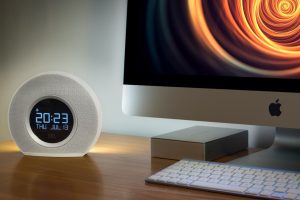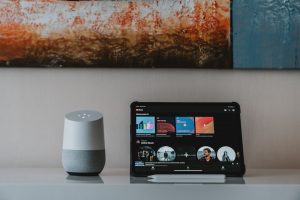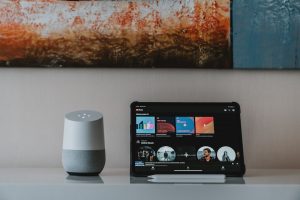Smart Home Devices 2025: Ideal for Eco-Conscious Families
Discover the top smart home devices of 2025 designed for eco-conscious families. Transform your home and reduce your carbon footprint today!
Top Smart Home Devices
Smart Speakers
In 2025, smart speakers remain a cornerstone of the smart home ecosystem. Devices like the Amazon Echo and Google Nest Audio have evolved with improved sound quality and more intuitive voice recognition capabilities.
These speakers not only play music but also control other smart devices, providing a seamless user experience.
With advancements in AI, smart speakers now offer personalized suggestions and can distinguish between different household members’ voices, offering a tailored interaction for each user.
Smart Thermostats
Smart thermostats have become essential for energy-efficient homes. The latest models, such as the Nest Learning Thermostat and Ecobee SmartThermostat, use AI to learn your schedule and preferences, adjusting temperatures automatically to save energy and reduce costs.
These devices now come with enhanced sensors that detect occupancy and humidity, ensuring optimal comfort while you’re home and energy savings when you’re away.
Smart Lighting
Smart lighting systems, like Philips Hue and LIFX, have advanced significantly in 2025.
These systems offer millions of color options and can be controlled via voice commands, apps, or automated schedules. The integration with other smart home devices allows for dynamic lighting scenes that can enhance mood and productivity.
Moreover, new features such as circadian rhythm lighting mimic natural light patterns, promoting better sleep and overall well-being.
Smart Security Systems
Home security has been revolutionized by smart security systems.
Leading products like Ring and Arlo offer high-definition video surveillance, motion detection, and real-time alerts. These systems can be accessed remotely, providing peace of mind whether you’re at home or away.
In 2025, integration with AI has enabled these systems to differentiate between potential threats and benign activities, reducing false alarms and enhancing security.
Smart Appliances
Smart appliances have made daily chores more convenient and efficient.
Refrigerators, washers, and ovens from brands like Samsung and LG now come with connectivity features that allow users to control and monitor them remotely. These appliances can also provide maintenance alerts and integrate with other smart home systems for a cohesive experience.
With energy efficiency being a top priority, smart appliances in 2025 are designed to minimize energy consumption while maximizing performance.
Features Comparison
Voice Assistant Compatibility
In 2025, smart home devices are more integrated with voice assistants than ever before.
Leading devices such as the Amazon Echo, Google Nest Hub, and Apple HomePod support seamless integration with their respective voice assistants. This allows users to control their smart home ecosystem using simple voice commands, enhancing convenience and accessibility.
While Amazon Echo and Google Nest Hub offer compatibility with a broader range of third-party devices, Apple HomePod stands out with its superior sound quality and privacy-focused features.
Users should consider their existing ecosystem and preferred voice assistant when choosing a device.
Energy Efficiency
Energy efficiency is a critical factor in the 2025 smart home landscape. Devices like the Ecobee SmartThermostat and Nest Learning Thermostat are equipped with advanced sensors and AI-driven algorithms that optimize energy consumption.
These devices learn user patterns and adjust heating and cooling settings automatically, leading to significant energy savings.
Additionally, smart plugs and lighting systems, such as those from TP-Link and Philips Hue, offer energy monitoring features that help users track and reduce their energy usage. This not only contributes to a greener home but also results in lower utility bills.
Security Features
Security remains a top priority for smart home devices in 2025.
Smart security cameras like the Arlo Ultra 2 and Ring Spotlight Cam offer high-definition video, night vision, and motion detection, providing users with peace of mind. These devices also integrate with smart locks, such as the August Smart Lock Pro, allowing for remote access and monitoring.
Furthermore, many devices now include advanced encryption and multi-factor authentication to protect user data from unauthorized access.
This ensures that personal information and home security footage remain secure.
Interoperability
Interoperability is a key feature for smart home devices in 2025. With the rise of the Matter protocol, devices from different manufacturers can now communicate more effectively.
This means that users can mix and match devices from brands like Samsung SmartThings, Amazon, and Google, creating a cohesive and integrated smart home environment.
The ability to control various devices through a single app or voice assistant simplifies the user experience and enhances the overall functionality of the smart home system.
User Experience Insights
Intuitive Interface
The best smart home devices of 2025 prioritize user-friendly interfaces that simplify interaction. Whether through touchscreens, mobile apps, or voice commands, these devices ensure that users can easily navigate settings and functionalities.
The emphasis is on reducing the learning curve, allowing users of all ages to operate the devices with minimal instruction. This intuitive design is crucial for enhancing user satisfaction and promoting widespread adoption.
Seamless Integration
In 2025, seamless integration has become a hallmark of top-tier smart home devices.
These devices are designed to work harmoniously with various ecosystems, including Google Home, Amazon Alexa, and Apple HomeKit. This interoperability ensures that users can effortlessly connect and control multiple devices from different manufacturers through a single platform.
The result is a cohesive smart home experience that enhances convenience and efficiency.
Personalized Experiences
Advanced smart home devices now offer personalized experiences tailored to individual user preferences. Through machine learning algorithms, these devices learn user habits and adjust settings accordingly.
For instance, smart thermostats automatically modify temperature settings based on past behavior, while smart lighting systems adapt to preferred brightness levels. This personalization not only enhances comfort but also optimizes energy consumption, contributing to a more sustainable lifestyle.
Enhanced Security Features
With increasing concerns about privacy and security, the best smart home devices of 2025 incorporate robust security features.
These include end-to-end encryption, multi-factor authentication, and regular software updates to protect against vulnerabilities. Users can also monitor and control their devices remotely, receiving real-time alerts on potential security breaches.
Such features provide peace of mind, making smart homes not only convenient but also secure.
Responsive Customer Support
Responsive customer support is a critical component of the user experience for smart home devices. Leading manufacturers offer 24/7 support through various channels, including chatbots, phone lines, and online resources.
This ensures that users can quickly resolve issues and receive guidance when needed. By prioritizing customer support, companies enhance user trust and loyalty, contributing to a positive overall experience.
Future Trends Analysis
Increased Interconnectivity
By 2025, smart home devices are expected to offer unprecedented levels of interconnectivity.
This trend is driven by advancements in IoT (Internet of Things) technologies, which enable seamless communication between devices. Homeowners will benefit from systems that can communicate across different platforms, allowing for a more integrated and efficient smart home environment.
For instance, a smart thermostat could automatically adjust settings based on data from smart blinds or lighting systems, optimizing energy use and enhancing comfort.
AI-Powered Personalization
Artificial Intelligence will play a pivotal role in the evolution of smart home devices. Future devices will leverage AI to learn user preferences and behaviors, offering personalized experiences that cater to individual needs.
This could manifest in smart speakers that curate playlists based on mood or smart refrigerators that suggest recipes using available ingredients. The integration of AI will make smart homes not just more convenient, but also more intuitive and responsive to the unique lifestyles of their inhabitants.
Enhanced Security Features
As smart home technology becomes more prevalent, the demand for robust security features will grow.
Future devices are expected to incorporate advanced security protocols to protect against cyber threats. Biometric authentication, such as facial recognition and voice identification, will likely become standard features, ensuring that only authorized users can access and control smart home systems.
Additionally, real-time monitoring and alerts will provide homeowners with peace of mind, knowing their homes are secure even when they are away.
Sustainability and Energy Efficiency
The push towards sustainability will significantly influence the development of smart home devices by 2025. Manufacturers will focus on creating energy-efficient products that reduce environmental impact.
Smart energy management systems will optimize power consumption by analyzing usage patterns and suggesting energy-saving measures. Furthermore, integration with renewable energy sources, like solar panels, will become more common, enabling homeowners to reduce their carbon footprint while enjoying the benefits of smart technology.
Voice and Gesture Control
Voice and gesture control technology will continue to evolve, offering more natural and intuitive ways to interact with smart home devices.
By 2025, improvements in voice recognition and gesture sensing will allow for more accurate and responsive control, even in noisy environments. This trend will make smart homes more accessible to a broader audience, including those with disabilities, by providing alternative methods of interaction that do not rely on traditional interfaces.
FAQ
Q1: Who should consider buying the best smart home devices of 2025?
A1: The best smart home devices of 2025 are ideal for a wide range of users, including tech-savvy homeowners looking to enhance their living spaces, busy professionals who want to automate daily tasks, and students who enjoy incorporating the latest technology into their routines. Additionally, frequent travelers can benefit from smart home security devices that offer remote monitoring and control, providing peace of mind while away from home.
Q2: Are the best smart home devices of 2025 compatible with other devices or software?
A2: Yes, the best smart home devices of 2025 are designed with compatibility in mind. They typically support integration with popular platforms such as Amazon Alexa, Google Assistant, and Apple HomeKit, allowing users to seamlessly control their devices through voice commands or centralized apps. Furthermore, many of these devices offer compatibility with IFTTT (If This Then That), enabling users to create custom automations and enhance interoperability with other smart gadgets and software.
Q3: When is the best time to upgrade to the latest smart home devices, or are there better alternatives?
A3: The decision to upgrade to the latest smart home devices depends on your current setup and specific needs. If your existing devices are outdated or lack desired features, upgrading to the 2025 models could significantly enhance your smart home experience. However, if your current devices are still meeting your needs, you might consider waiting for sales events like Black Friday or Cyber Monday for better deals. Additionally, researching upcoming product releases can help you determine if holding off for a newer model or alternative brand might be more beneficial.
Takeaway
Ready to make an informed decision on your next tech purchase? Dive into hands-on product reviews, compare specs of similar gadgets, and get all the details you need by visiting our site. We’re here to help you find the perfect match for your needs. Let’s explore together! Industry analysts believe this signals a shift in market dynamics.
References
- Statista (2024) reports global smart home device revenue to exceed $170 billion by 2025.
- Samsung leads in mobile and smart home device ecosystems with its Galaxy and SmartThings platforms.











Comments